With the football season currently on hold, Aston Villa will be desperate for it to start again or the season to be voided as Dean Smith’s side are currently 19th in the Premier League but only two points behind both Watford (17th) and West Ham (16th) with a game in hand. It is a battle that Villa would have expected to be in at the start of the season however with ten games still left to play Villa will strongly believe they have what it takes to get out of the relegation zone. Nevertheless with only three wins and one draw out of their previous ten league games something needs to change if Villa wants to stay up.
This tactical analysis will break down Smiths side and provide analysis on the problem areas as well as the strengths this team has, and to see if his team does indeed have the capability of surviving if the season resumes.
Formation
Throughout the season Dean Smith has opted for different formations partly down to injuries in the squad but also to be tactically set up in the right way depending on their opponents. However, he hasn’t always got it right at times this season which has left Villa vulnerable. For example, in their 6-1 defeat at home to Manchester City, Smith opted to use a 5-3-2 formation to have the defensive solidity to keep City quiet. The main problem came from the lack of protection the midfield and forward lines offered to the defensive line. With Villa side sitting deep for large portions of this match; it enabled City to drop players into deeper positions to create overloads in the middle to progress play into the final third before looking for the killer ball.
Nevertheless, for the majority of the season, Smith has opted for the 4-1-4-1 formation. With this system for Villa, it puts more emphasis on the roles of the wide midfielders and striker. This is designed to try and get Jack Grealish on the ball as much as possible. What Villa then tries to do is get the forward into the channels around the outside of the centre-halves. The system also provides a flat four that can sit in front of the back-line with the defensive midfielder operating in the pocket.
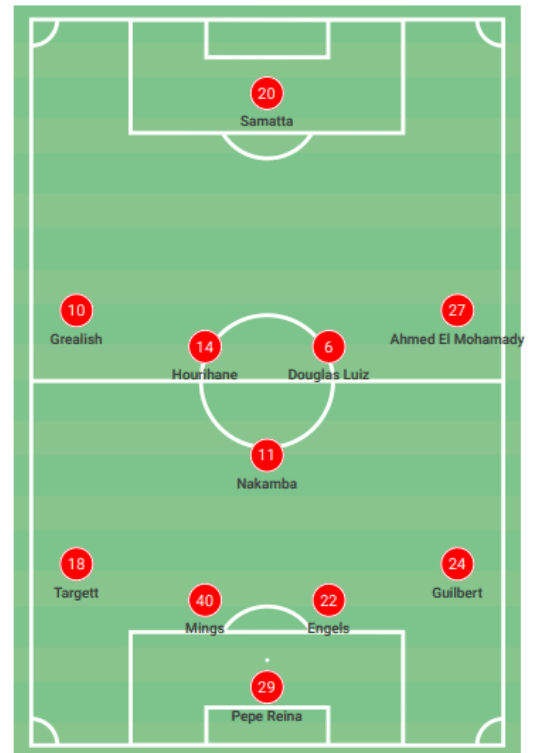
Defensive structure
Villa initial defensive shape starts when teams have the ball on the halfway line. Villa looks to control the central areas within their half they do this by switching from a 4-1-4-1 to a 4-3-2-1. This starts with a compact back four as the full-backs will tuck in meaning they are close to the centre-backs, this makes it difficult for teams to then play through balls in this area, instead, it forces teams out wide. the midfield will also maintain central positions, but interestingly they will push up from the defence so they are covering the middle of the half this is so they are ready to put pressure on the ball when it enters this section of the pitch again the narrow structure is designed to force their opponents wide. The formation then changes to a 4-3-2-1 as the two wide players will push up so they are just behind the striker.
Looking at the image below notice how Grealish and Ahmed Elmohamady have moved up to just behind Mbwana Samatta this is to maintain the narrow structure. However, the two wide players will constantly be moving from this central position to a slightly deeper position alongside the midfield. This happens depending on where the ball is as when the midfielder or centre-back is on the ball in a central position the two wide players will push up to keep the narrow structure. Then when the ball moves out wide depending on the side of the pitch either Grealish or Elmohamady will move into the highlighted area. In this situation, it would be Elmohamady that would move across. Notice how it is still a narrow position as it makes it difficult for teams to then move inside.
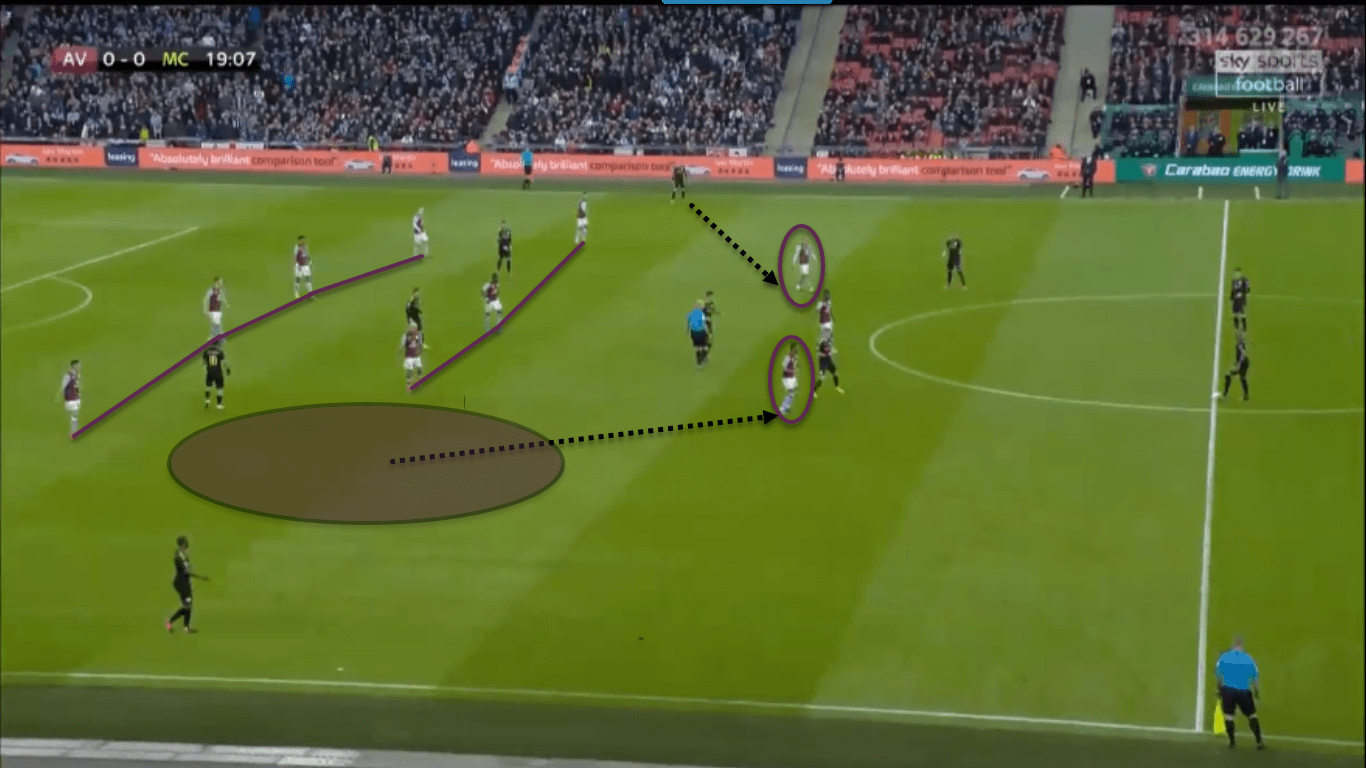
Next phase of defending
So far the analysis has looked at Aston Villa’s initial defensive structure. This changes between a 4-1-4-1 and a 4-3-2-1. This then changes when their opponents move into the final third. To become more compact the 4-1-4-1 will switch to a narrow 4-5-1. This happens as the back four will drop back into the box to be compact. What this does is set Villa up if a cross comes in, with four players in a tight area and with Tyrone Mings being 6.4ft and Björn Engels being 6.3ft Villa will also back themselves in the air.
The midfield will also drop back and as the image below shows, they will form a flat line on the edge of the penalty area. Dean Smith has adopted this tactic as he wants the midfield to provide a defensive wall on the edge of the penalty area. What this does is limit the shooting opportunities in key areas as the number of bodies in a central area means that teams do not have the space to shoot.
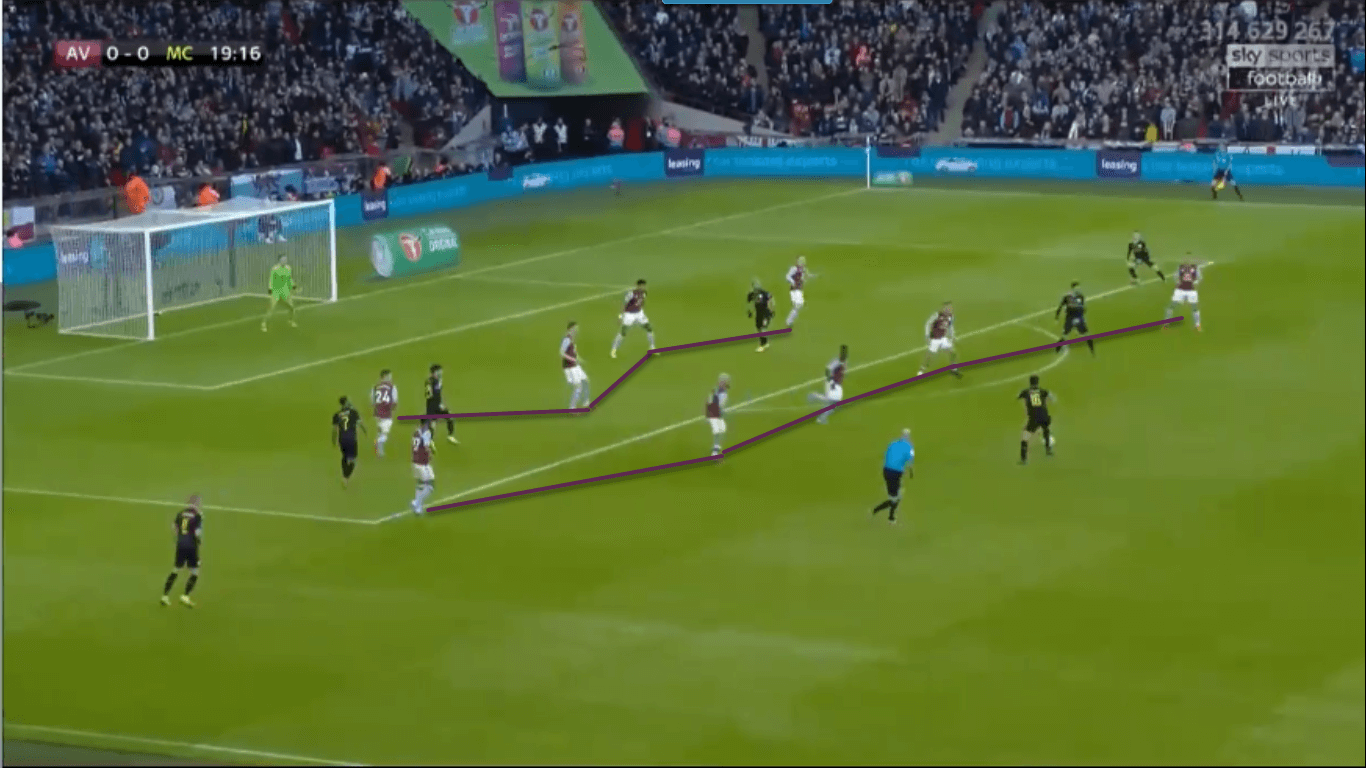
Does it work?
Looking at the stats, the answer is no it doesn’t work. Smith’s side has the worst defensive record in the league having conceded 56 goals in the Premier League. Villa also has the second most defeats in the league with 17 only Norwich has more in 18. This demonstrates that something is clearly wrong in the way they are set up as their opponents this season have average expected goals of 2 whereas Villas is only 1.33. What is also worrying for Villa is that this compact structure requires the defence to win their aerial duels, which is not happening. In fact focusing on Villa aerial duels in their previous five-fixture, all of which they lost, Engels has only won 33.% (2/6) and Frédéric Guilbert has only won 27.3%(3/11) of his aerial duels. Mings is better as he has won 4 out of 5 (80%) but only 50% of his duels in the penalty area. This may not appear as many aerial duels but because of the positioning of the defenders losing theses, aerial battles means that the opponents are able to get a header at goal.
Another reason defending this way is not effective for Villa is the defensive wall they have set up on the edge of the box does not stop the opponent’s midfield from having time on the ball. The picture below is the same image as the one above demonstrating Villa’s compact set up, however, in this illustration; it now highlights the space Rodri has on the ball. It also exposes the gaps out wide that Villa has left. The defensive wall may be there to stop the shot but it does not prevent the clipped ball around the side. As highlighted, all it takes for City to open the scoring is a simple run from Phil Foden into space out wide, because of Villa set up Rodri has time to find this pass, as it goes around Villa’s set up it takes the midfield out of the game meaning Sergio Agüero only needs to move into the gap between the defence and midfield for City to score.
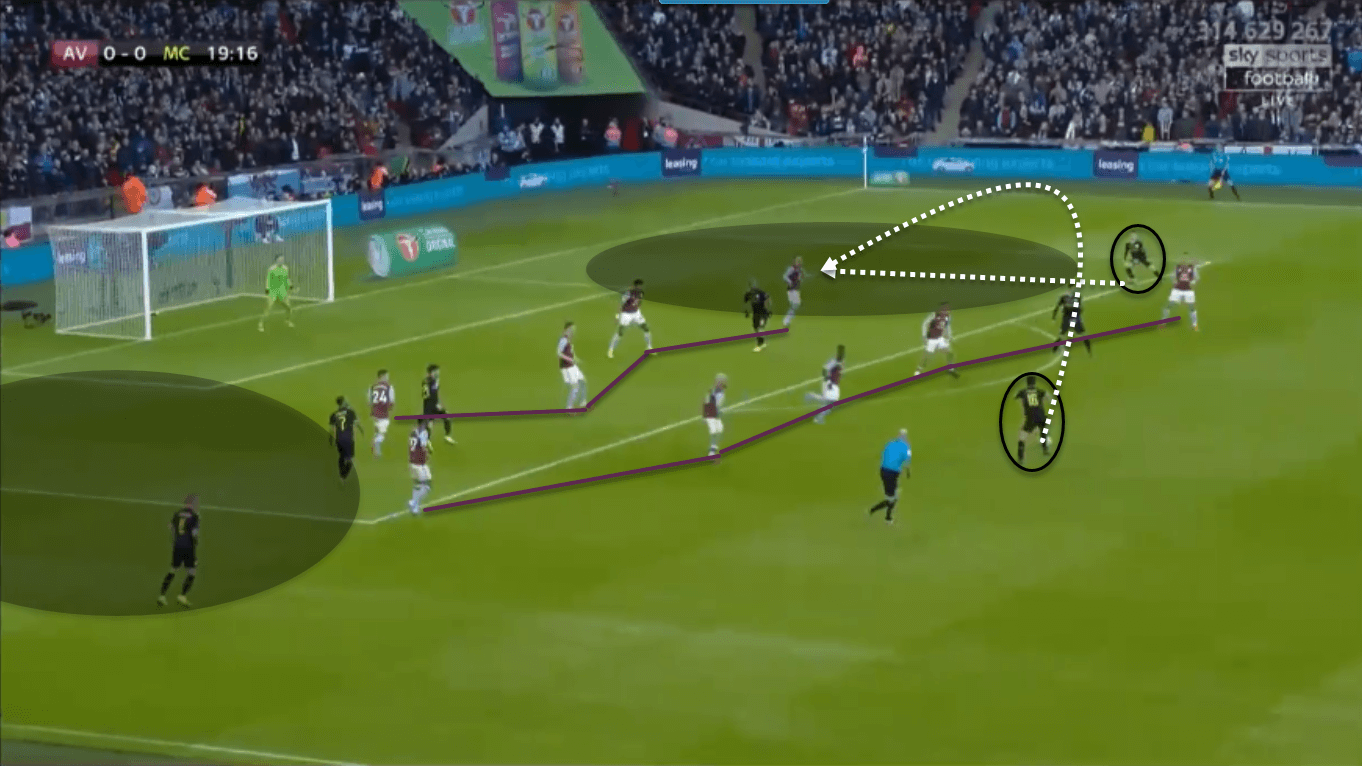
Too many gaps
The tactical analysis has mentioned how Villa compact system in the final third leaves gaps out wide, this is also true with their defensive structure in the first phase of defending as mentioned Villa want to be set up to force their opponents wide and then control the space in the middle. However, this has caused Villa defensive issues as it leaves too many gaps in between the lines. This is not helped by the fact that their Pressing Per Defensive Action (PPDA) is 12.99 compared to their opponents average of 10.64.
This is particularly true against teams that like to attack down the side as they will look to get the wide players on the ball as much as possible and use the players in the middle as an option to bounce the ball off. Looking specifically at the example below against relegation rivals Watford, the away side want to get the wide players like Gerard Deulofeu on the ball as much as possible as he has the ability to drive past players. Therefore in the example below Deulofeu has picked up the ball in a wide position triggering Villa’s left midfielder to move out to him. However, as the midfield are trying to cover the space in the middle it leaves a gap between the midfield and defence that Abdoulaye Doucouré is able to exploit. As Doucouré can pick the ball up in this space he can then complete the one-two with Deulofeu enabling the winger to get in behind where he has time to pick out Troy Deeney with the cross who then heads home to give Watford the lead. Villa were able to fight back and win this game but it was helped by the fact that Watford missed other chances like the one they created here.
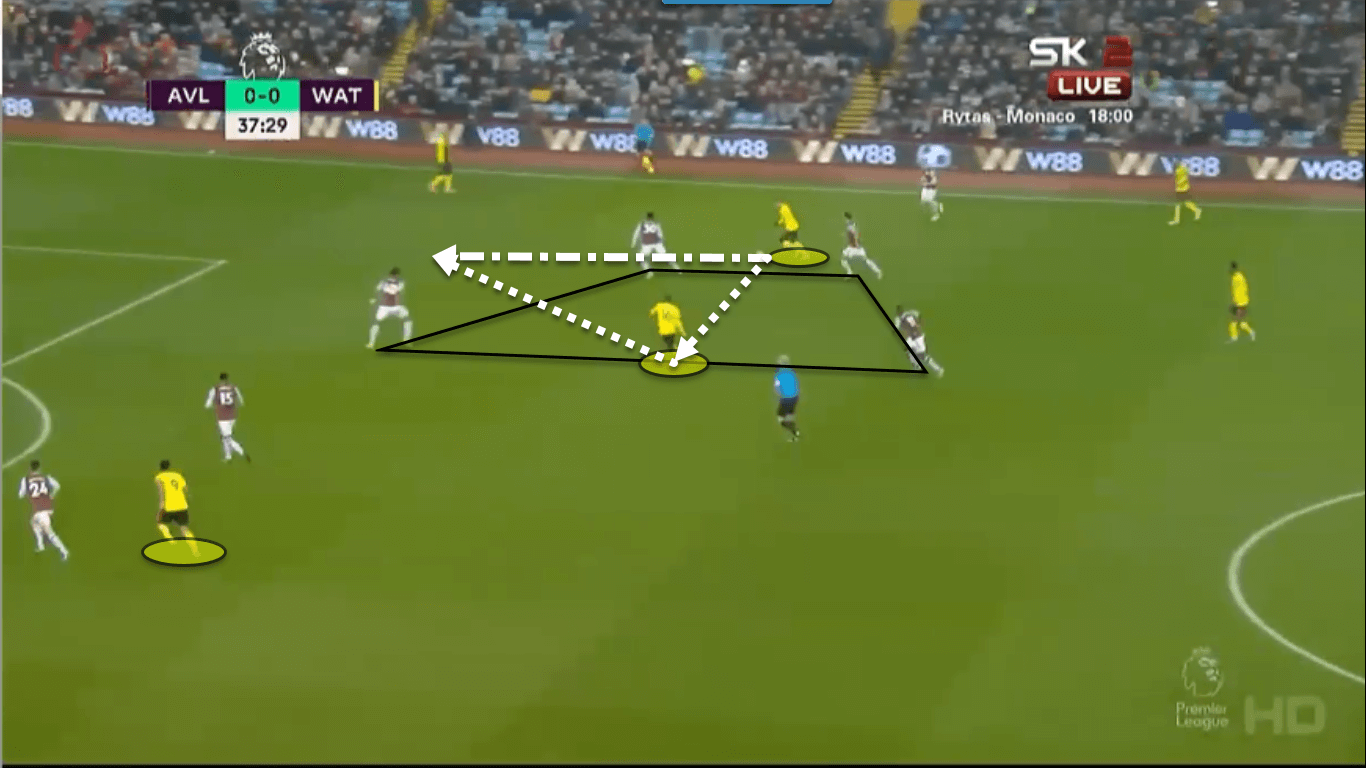
How Aston Villa want to attack
So far this tactical analysis has broken down Dean Smith’s defensive tactics using the 4-1-4-1 system. As the analysis has mentioned the way Villa have been using the system has caused them defensive issues, however, it is a crucial part of the way that Aston Villa want to attack teams. Unlike their defensive set up which designed to be narrow Aston Villa want to attack teams down the side.
Aston Villa has at times switched to using three central defenders but the way they want to build attacks maintains the same as when using three defenders the middle centre-back will drop back slightly to provide the middle pivot to move the ball out wide. However, the benefit of the 4-1-4-1 enables the defensive midfielder to drop back in between the two centre- backs this is a more advanced position than when with three defenders. Villa wants to attack by getting the ball wide to the full-backs or wingers and will do this by playing the ball around the back. However, if an opposition winger moves into a position to cover this pass the defensive midfielder then provides the pass in the middle.
Using the example below Marvelous Nakamba is playing the defensive midfielder role. As illustrated he has moved to a deep position to be the pivot in the middle. What this also does is draw in the press from Manchester City, as Villa are aware they want to press high and in order for Villa to build attacks down the side, Nakamba draws the press inside creating space out wide.
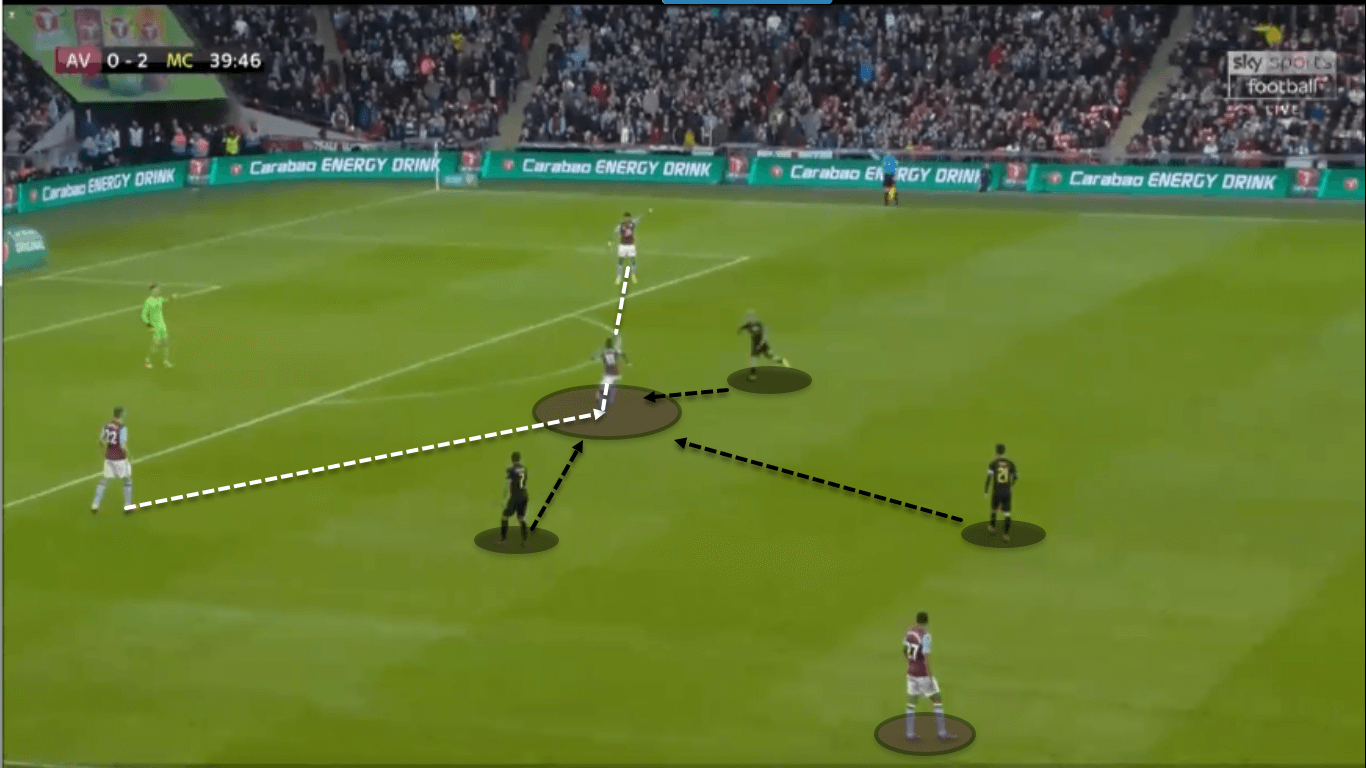
Aston Villa will particularly try to move the ball out to left side to get Grealish involved in the game as quickly as possible in fact over the last five games 44% of Matt Targett 36 passes in the build-up of an attack have been to Grealish, 38% to Samatta. The reason they will particularly want to target Grealish’s side early is he will drop back into the pockets in the opposition midfield.
As the example below shows, Villa have been able to get the ball out wide to the full-back, this then triggers Grealish to find a pocket in the middle where he then has the ability to quickly turn under pressure and find the pass forward.
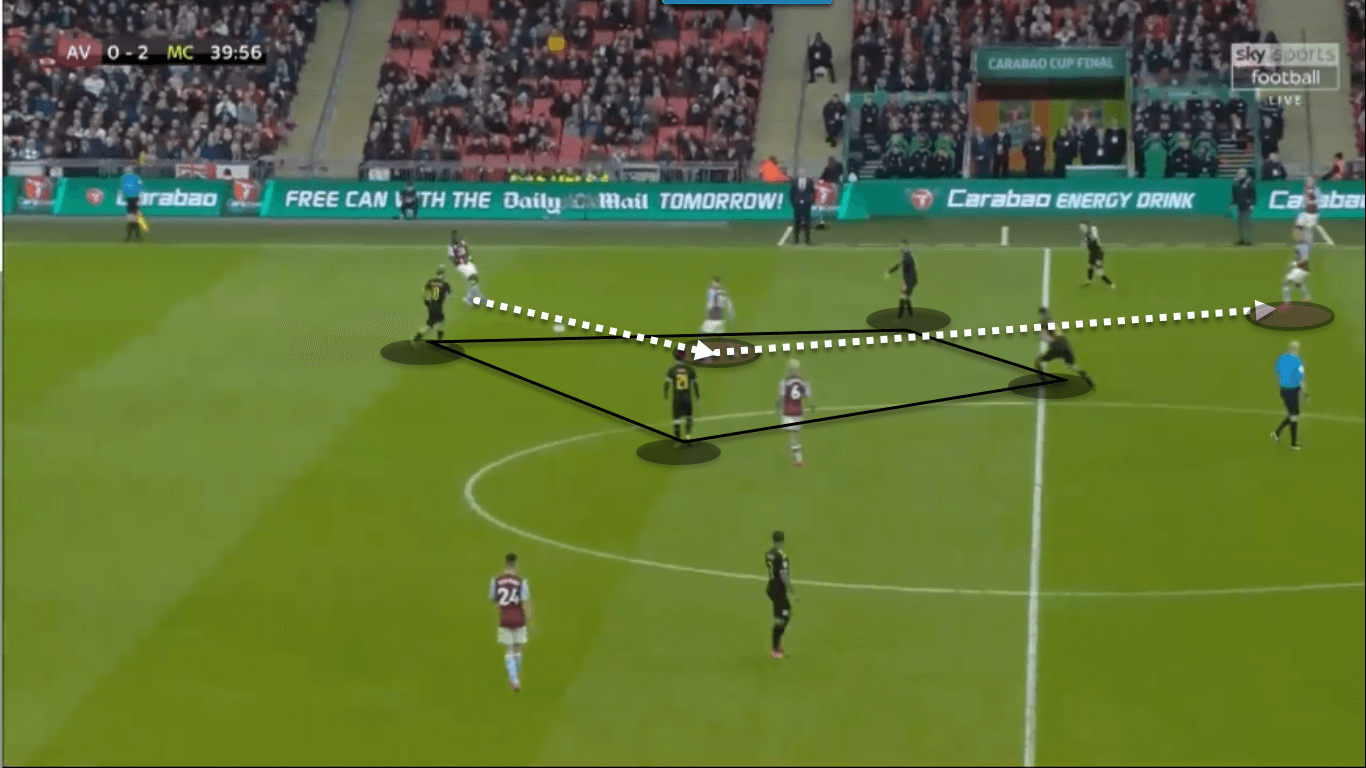
What this movement from Grealish has done is dragged the opposition midfield higher up the pitch. As soon as Grealish has then made the forward pass he will then move forward in the same direction as the pass so he is keeping himself close to the play. What this does is it keeps opposition players around him creating more space in behind, as in the next phase of the attack Grealish will play the ball back out wide to the full-back who has moved up the pitch. As a result of this Villa are then able to target the space they have created in the box and on this occasion, this move finishes in a goal.
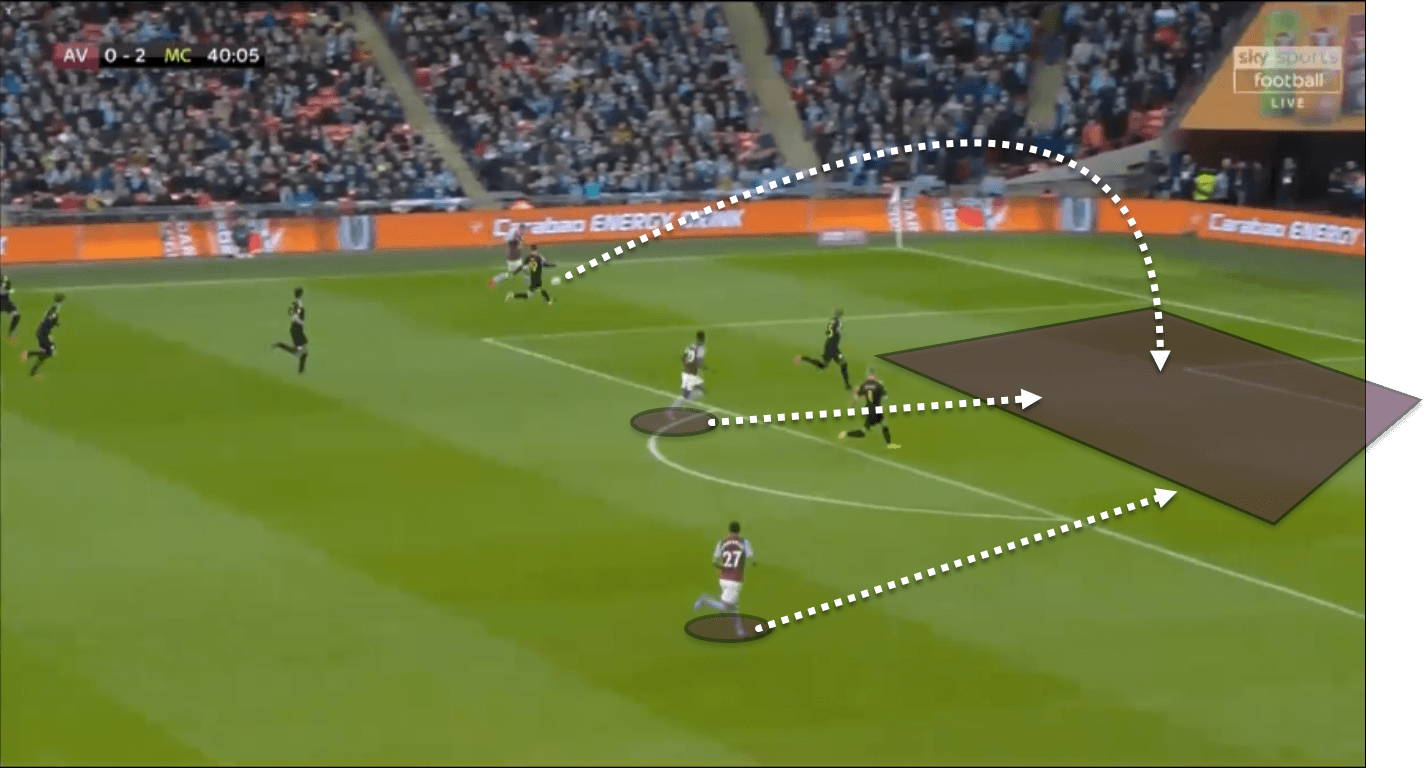
What Jack Grealish brings
When considering if Villa can stay up the one major factor is their talisman, Jack Grealish. With 7 goals and 6 assists in the Premier League. This is largely down to Grealish’s aggressive dribbling style as he attempts nearly 6.82 dribbles per 90 minutes, with a 57% success rate. Showing he is good at it. He also prefers to drive at opponents directly with the ball at his feet than make penetrative passes as it means he can take the team forward while keeping close to the play. This is proven by the fact he makes 4.43 progressive runs per 90 only Adama Traoré makes more (5.6) per 90 in the Premier League.
His goal contribution is vital to Villa but what is also crucial is how forward-thinking he is. Looking in particular at his pass map against Tottenham Hotspur it shows just how Grealish is looking to get Villa to progress forward. In fact, Grealish had an 83.8% pass success ration in this game and when looking at how many forward passes he makes this is impressive and crucial for Villa as often most attacks go through him.
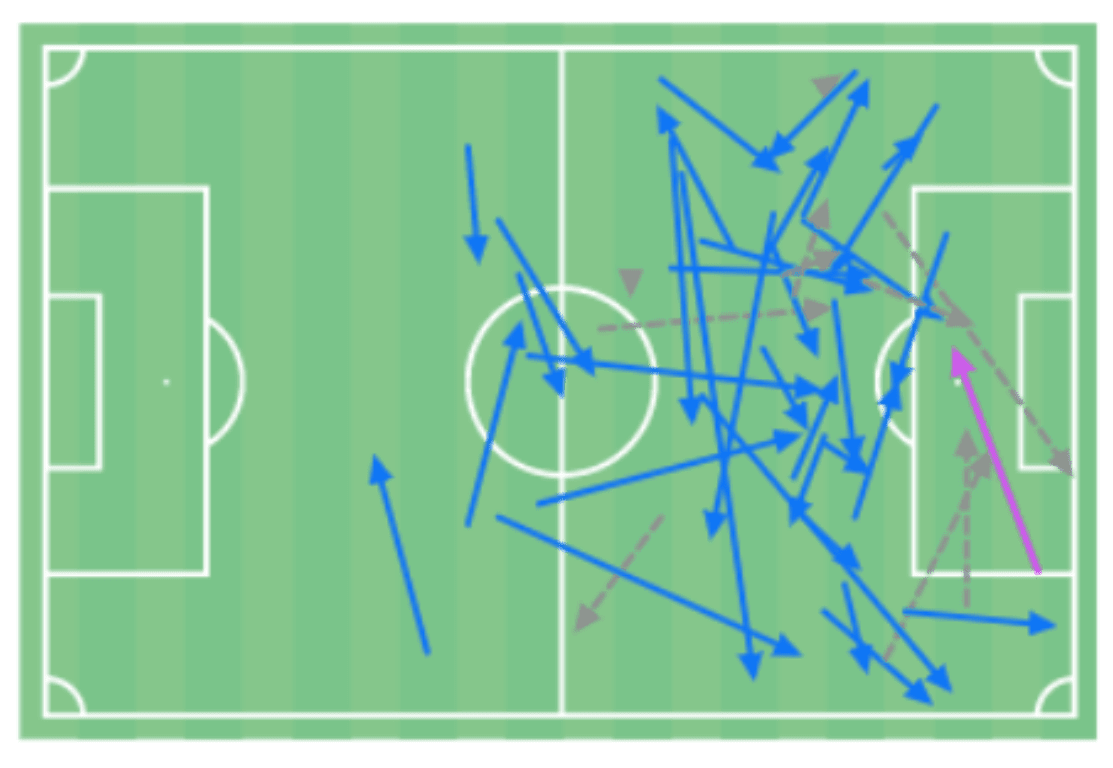
Other ways of building an attack
As Jack Grealish is Aston Villa’s key player it means that teams will target him and try to mark him out of the game, as a result, this means that Villa have to attack in different ways. As this analysis has mentioned Villa want to attack down the side and do this by constantly rotating the ball around the backline until the pass to the full-back or wide player is available.
Looking at the example below it demonstrates the type of situation Villa are trying to create as playing the ball around the back has drawn their opponents on to them meaning when they do get the ball out wide Villa’s wide player has space to drive forward into and get Villa up the pitch. Villa will also look to get the ball out wide by using the two central midfielders as options inside to play the ball off so they can continue to move up the pitch.
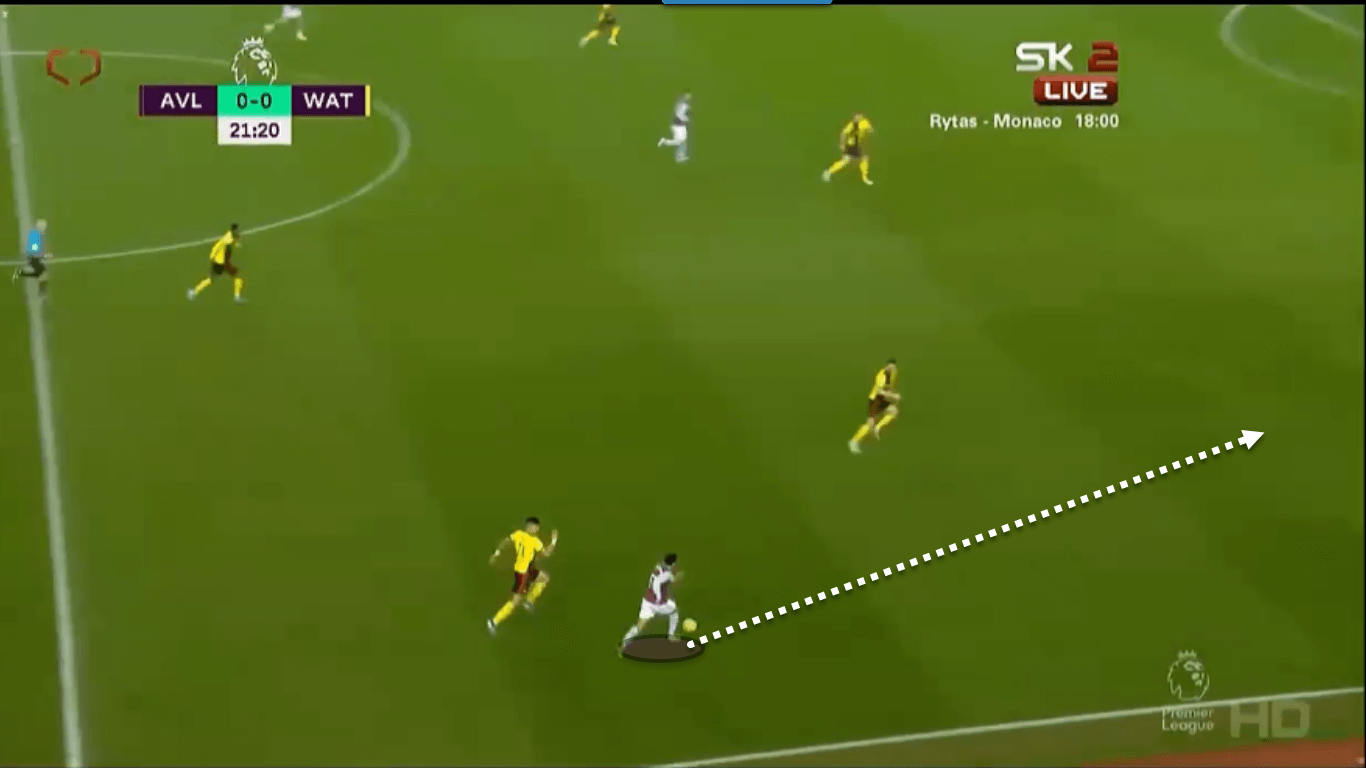
Forward movement
The tactical analysis has mentioned how Dean Smith wants his team to attack down the side. However, if teams push up it can make it difficult for Villa to play this way. As a result, they need to look at another way to get up the pitch. This will then happen because of the striker’s movement. Villa still wants to target the wide areas of the pitch and to do this they need the striker to move out of a central position.
In the image below, it shows the type of run that Samatta will make. Using Watford’s 4-2-3-1 as an example Samatta will run into the gap behind the defensive midfielder and in between the full-back and centre back. Villa target this area as it is an area where the wide player can get to quickly and therefore allowing Villa to create a two vs one against the opposition full-back. What this clipped pass also does is take out the players applying the press meaning there is more space for Villa to target in behind.
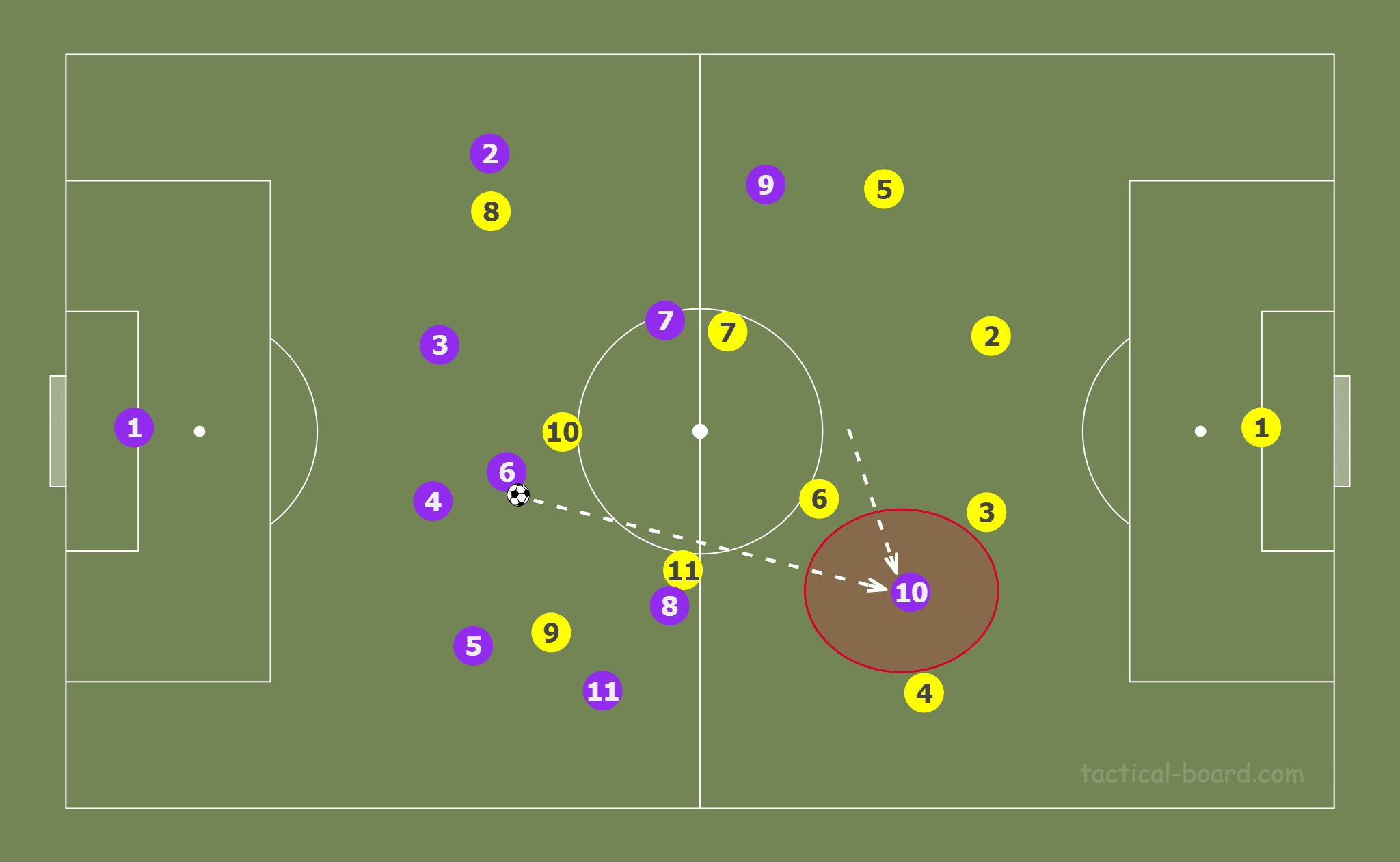
Being predictable
This tactical analysis has broken down Dean Smith’s offensive tactics. It is clear to see that Villa want to attack down the side and especially go through Grealish. However, what this does mean is that Villa are predictable in the way they are wanting to play. As a result, teams can set up to force Villa to attack down the right.
Aston Villa’ predictability can be shown by their pass map against Tottenham Hotspur. In this game, Villa had 55% possession but had to make 65 back passes and 147 lateral passes compared to Spurs’ 34 and 112 illustrating they struggled to get forward. This is also highlighted by the fact that out of their 55 passes to the final third 34 where accurate (61.82%) whereas with 10% less of the ball Spurs made 41 out of their 64 passes to the final third (64.4 %). The pass map demonstrates how much Villa want to attack down the left and through Grealish, therefore showing how Villa attacking style is predictable. This does not necessarily mean it is simple to defend against as Grealish is unpredictable and his technical ability to get Villa moving forward is difficult to defend against.
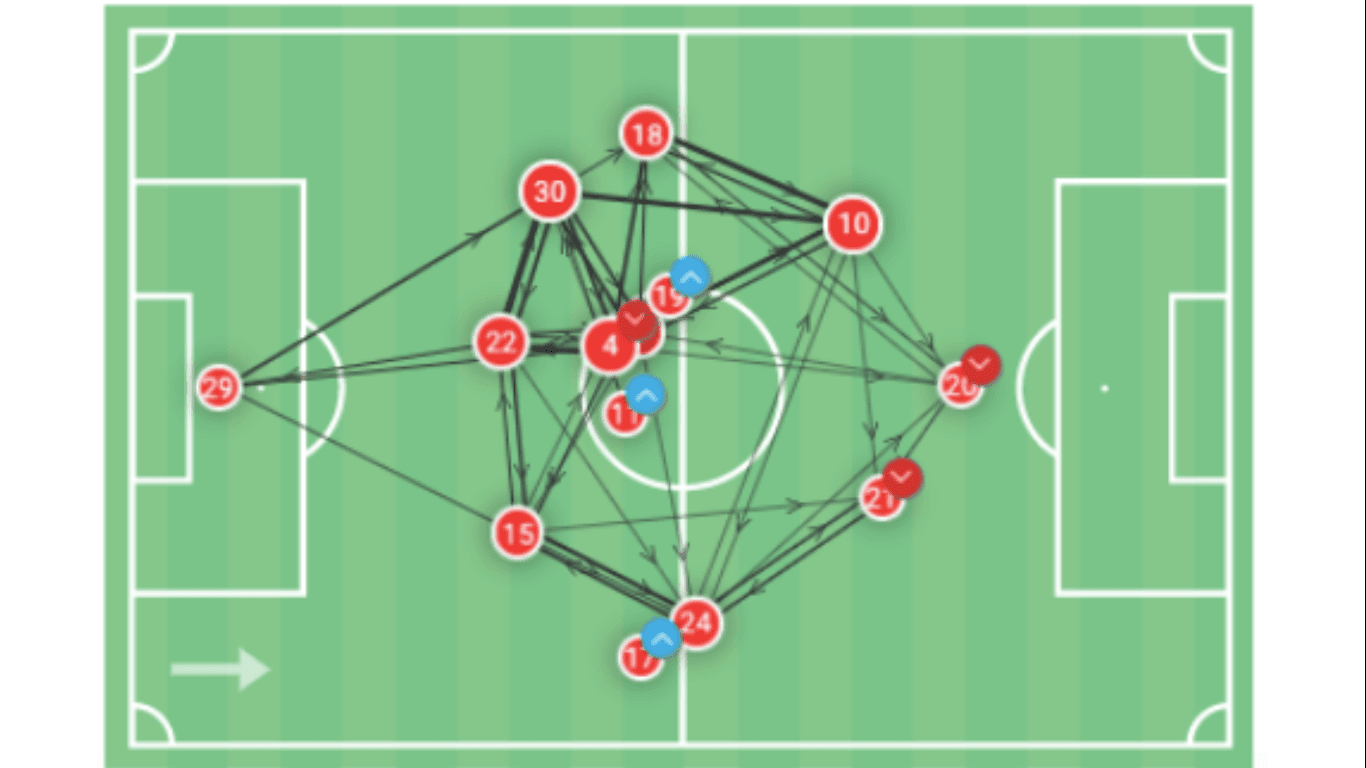
Conclusion
To conclude this tactical analysis it is clear that Dean Smith does have a difficult job to get Aston Villa to stay up if the season does resume. However, there are definitely a few factors in Smith favour one of which being Jack Grealish. The Villa talisman will be desperate to keep his boyhood team in the Premier League and is more than capable of winning games on his own. The other factor in Villa’s favour is their fixtures, they do have a few difficult games remaining but with six out of their ten remaining games at home the home crowd could be a big influence and with two of their away games being to Newcastle and West Ham it is likely that Villa may have enough fight to get out of the relegation zone, especially when you look at Brighton and Bournemouth’s remaining fixtures as both teams still have to play five of the top six teams.






Comments